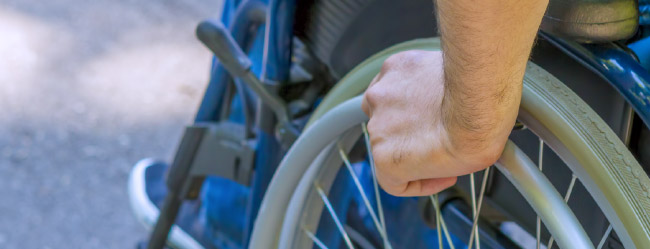The following fictional Case Studies have been designed to help you understand what treatment, care and support the Lifetime Support Authority can provide.
Lisa suffered severe spinal injuries (T4 ASIA A spinal cord injury). Lisa could not feel or move anything below her shoulders. Lisa never lost consciousness and also fractured her spine at C3 and C4 vertebrae.
The hospital staff identified that as a result of the spinal injury, Lisa was likely to be eligible for the Lifetime Support Scheme (LSS). A social worker from the Women’s and Children’s Hospital contacted the Lifetime Support Authority (LSA) to advise.
Application
The LSA Lead Service Planner went to the hospital to meet with Lisa’s mother and father, who were making decisions for Lisa as she is a minor. The Lead Service Planner explained to Lisa’s parents what the Scheme was and completed an application with them.
The LSA sought information from the Police to confirm the Motor Vehicle Accident and the medical team provided information to confirm eligibility. Lisa was accepted as a lifetime participant of the LSS. From the date of acceptance the LSS began funding Lisa’s hospital care including any medical investigations and pharmaceuticals required.
Hospital & Rehabilitation
A Service Planner from the LSA was allocated to Lisa. Lisa could not control her bowels or bladder and she would require a wheelchair as part of her rehab program. The family were having difficulty coping with Lisa’s accident so the Service Planner arranged counselling.
Lisa’s mother and father also had difficulty understanding the changes in Lisa in terms of physical ability and continence, so a support and information session was arranged for them, to understand a spinal cord injury and what they might expect. The Service Planner maintained regular contact with Lisa’s mother and father and attended meetings with the family in the rehabilitation ward of the Women’s and Children’s Hospital.
To facilitate discharge to home the following was arranged:
- Equipment – manual wheelchair, shower chair, pressure care mattress.
- Medic alert bracelet due to autonomic dysreflexia.
- Home modification – ramp to front door, bathroom refit to allow access to the shower and washbasin, widening of bedroom door.
- Attendant care – in the morning to assist with shower and dressing. In the afternoon to assist with night time routine.
- Transport reimbursement of parent’s travel kilometres to appointments relating to the motor vehicle injuries (MVI).
1st Year Home
Once Lisa discharged home her Service Planner visited her within a few days to review the arrangements in place. Lisa had daily attendant care to assist her with personal care and community integration (return to school). An occupational therapist (OT) was arranged to assess her school for accessibility. Lisa will continue to attend the Women’s and Children’s Hospital ambulatory rehabilitation program which includes occupational therapy, physiotherapy and psychology and attend school part time.
The following additional services were also provided:
- Home modification – kitchen modification lowering bench tops and creating space for the wheelchair under the bench to allow Lisa the ability to prepare her own breakfast and bake with her Mum (she enjoys this activity).
- Hydrotherapy and wheelchair basketball introduction.
- Vehicle modification – family sold their car to purchase a vehicle that could be modified for wheelchair access (the vehicle modifications funded by LSA).
- Counselling for the family.
- GP consultations and medical Intervention/treatment (including surgery) relating to the MVI.
- Rehabilitation specialist consultations.
- Pharmaceuticals and continence supplies for her catheter.
- Travel reimbursement for travel in her parent’s car to and from appointments relating to MVI.
- Occupational therapy to support return to school transition. This would include school wheelchair accessibility assessment and assistance with negotiating any modifications required e.g. – ground level locker, ramps, playground equipment etc.
Ongoing Treatment, Care and Support
Lisa’s rehabilitation services will continue periodically as new goals are identified. This is particularly important as Lisa transitions through childhood, adolescence and adulthood.
- Psychology intervention.
- Ongoing attendant care.
- Equipment repairs, maintenance and replacement.
- Continence review assessments and ongoing catheter supplies.
- Educational support services.
- Bursts of therapy services as required.

Due to the nature of Jacob’s injuries he was rushed to the Royal Adelaide Hospital where the doctors advised his girlfriend Kayla, whom had not sustained any major injuries that Jacob’s right leg was badly injured and would need to be amputated from below the knee.
The hospital identified that as a result of the amputation, Jacob was likely to be eligible for the Lifetime Support Scheme (LSS). The hospital social worker contacted the Lifetime Support Authority (LSA) to advice.
Application
The Lead Service Planner went to the hospital to meet with Jacob and Kayla to provide information about the LSA. The Lead Service Planner explained to Jacob and Kayla what the Scheme was and sat with them while they completed the application
for Jacob.
The LSA sought information from the police reports to confirm the details of the car accident and the medical team provided information to confirm eligibility.
Due to Jacob’s amputation he was accepted as a Lifetime Participant of the LSS. This means from the date of acceptance the LSS would pay for Jacob’s treatment care and support for the rest of his life including any hospital care related to his injury.
Hospital and Rehabilitation
A Service Planner was allocated to Jacob and visited Jacob in the rehabilitation hospital. Due to Kayla being involved in the accident with Jacob she was still traumatised. Kayla had difficulty understanding Jacob’s injury and what to expect now that his leg had been amputated. Jacob’s Service Planner arranged for some counselling for both Jacob and Kayla.
The Service Planner maintained regular contact with Jacob and Kayla and attended meetings with the family in the Rehabilitation ward of the hospital. To facilitate discharge the following was arranged:
- Equipment – manual wheelchair and cushion, shower chair and toilet seat raise.
- Home modification – ramp to front door, bathroom refit to allow access to the shower and washbasin, widening of bedroom door to allow wheelchair access.
- Transport – reimbursement of Kayla’s travel to appointments relating to the motor vehicle accidents, provision of taxi vouchers for approved treatment, care and support appointments.
- Pharmaceutical account for approved medications relating to motor bike accident.
1st Year Home
Once Jacob discharged home his Service Planner visited him within a few days to review the arrangements in place. The Service Planner arranged an occupational therapist to visit Jacob’s home to do an assessment for any other equipment he may need for everyday living.
Jacob also attended physiotherapy at Hampstead three times a week and the amputee day rehab. The day rehab program worked with Jacob to fit and trial different prosthesis and make any recommendations to the Service Planner about the best option for Jacob.
The following services were also provided:
- Further home modifications such as access paths in garden, allowing independent walking.
- Hydrotherapy.
- Vehicle modifications – to allow Jacob to drive his car.
- Counselling for Jacob and his girlfriend Kayla.
- GP consultations and medical intervention/treatment related to the motor vehicle accident injuries (MVI).
- Rehabilitation specialists consultations.
- Travel reimbursement for approved treatment care and support.
- Occupational therapy to support return to work transition – this would include a graduated return to work program and any other necessary work place modifications.
Ongoing Treatment Care and Support
Jacob’s rehabilitation services will continue periodically as new goals are identified.
- Prosthesis provision and ongoing review maintenance.
- Psychology intervention.
- Equipment repairs, maintenance and replacement.
- Return to work support.
- Bursts of therapy services including physiotherapy as required.
- Gym membership to support a regular exercise program.
Download the Case Study

Due to the nature of William’s injuries he was airlifted to the Royal Adelaide Hospital where they discovered he had a bleed on the brain. William had to have a number of surgeries including surgery to drain the blood from his brain.
The hospital identified that as a result of the brain injury William was likely to be eligible for the Lifetime Support Scheme (LSS). The hospital social worker contacted the Lifetime Support Authority (LSA) to advise.
Application
The LSA Lead Service Planner went to the hospital to meet with William’s wife Dianne, who was making the decisions for William, as he was unable to. The Lead Service Planner explained to Dianne what the Scheme was and completed an application form with her.
The LSA sought information from the police reports to confirm the car accident and the medical team provided medical information to confirm eligibility. William was accepted as an interim participant of the LSS. From the date of acceptance the LSS began funding William’s hospital care including any medical investigations and pharmaceuticals required.
Hospital & Rehabilitation
A Service Planner was allocated to William. Dianne and William live in regional South Australia so the Service Planner assisted Dianne to source some accommodation to stay nearby William to provide therapy support. She initially found it challenging to understand his brain injury and what to expect. A support and information session was also arranged.
The Service Planner maintained regular contact with Dianne and assisted to facilitate access to a bed at a specialty inpatient brain rehabilitation unit. Once William was transferred to rehab his Service Planner kept in contact with him, Dianne and the treating rehabilitation team.
To assist William’s rehabilitation and eventual discharge, the Service Planner arranged the following:
- Equipment – shower chair, walking stick, technology to use a memory aid.
- Home modifications – rail at front door (3 steps).
- Attendant care – assistance with personal care (showering and dressing), assistance completing the therapy directed exercises from the speech therapist, occupational therapist and physiotherapy.
- Transport – reimbursement for travel and taxi to appointments relating to the motor vehicle injuries (MVI).
- The Community rehab team to continue therapy once home.
1st Year Home
Once William discharged home his Service Planner visited him within a few days to review the arrangements in place. William had daily attendant care to assist him with personal care, meal preparation and with daily organisation and planning. The following week William commenced community based rehabilitation including speech pathology, occupational therapy, physiotherapy and psychology.
The following additional services were also provided:
- Gardening and home maintenance activities. Counselling and education for his wife Dianne.
- GP consultations relating to the MVI.
- Rehabilitation specialist consultations.
- Pharmaceuticals and continence consumables.
- Pre-screen for driver assessment. Mobility scooter.
- Smart phone for memory strategies and prompting.
- Taxi vouchers and reimbursement for travel in wife’s car to and from appointments relating to MVI. Neuropsychologist and geriatrician assessment.
- Fall and balance group exercise class at local aged care facility.

Jane was transferred to hospital and placed in an induced coma. Medical imaging showed that Jane had sustained a severe brain injury. Jane also sustained a traumatic amputation of her right arm up to her elbow.
The hospital staff identified that as a result of the brain injury and amputation that Jane was likely to be eligible for the Lifetime Support Scheme (LSS). The hospital social worker contacted the Lifetime Support Authority (LSA) to advise.
Application
The Lead Service Planner went to the hospital to meet with Jane’s mother, who was making decisions for Jane whilst Jane was unable to. The Lead Service Planner explained to Jane’s mother what the Scheme was and completed an application form with her.
The LSA sought information from SAPOL to confirm the car accident and the medical team provided medical information to confirm eligibility. Jane was accepted as a participant of the LSS. From the date of acceptance the LSS began funding Jane’s hospital care including any medical investigations and pharmaceuticals required.
Hospital & Rehabilitation
A Service Planner was allocated to Jane. The children were having difficulty coping with Jane’s accident so the Service Planner arrange counselling for the children. Once Jane was brought out of the coma she was in post traumatic amnesia and was very restless. Jane’s mother had difficulty understanding these changes in Jane so a support and information session was arranged for Jane’s mother to assist her to understand brain injury and what she might expect.
The Service Planner maintained regular contact with Jane’s mother and assisted to facilitate access to a bed in rehabilitation. Once Jane transferred to rehabilitation, the Service Planner maintained contact with Jane’s mother, the rehabilitation team and attended the regular family meetings.
To assist Jane’s rehabilitation and eventual discharge from rehabilitation the Service Planner arranged the following:
- Equipment – wheelchair, quad stick, shower chair, toilet raise, bed blocks, spike board, right handled knife and lipped plate.
- Home modifications – bath removed and level access shower installed, grab rails, ramp at front door, threshold ramps at internal small steps, and bathroom door widened.
- Attendant care – to facilitate overnight and weekend leave to assist with self care and support for parenting children.
- Transport – provision of taxi vouchers to and from appointments and leave to and from the rehabilitation centred.
- Prosthetic for her right arm and associated liners etc.
1st Year Home
Once Jane discharged home her Service Planner visited her within a few days to review the arrangements in place. Jane had daily attendant care to assist her with personal care, meal preparation, parenting support and other domestic activities. The following week Jane commenced community based rehabilitation including speech pathology, occupational therapy, physiotherapy and psychology.
The following additional services were also provided:
- Vehicle modifications including spinner knob.
- Counselling for children and mother.
- Gardening and home maintenance activities.
- GP consultations.
- Rehabilitation specialist consultations.
- Pharmaceuticals and continence consumables.
- Driver assessment and retraining.
- Taxi vouchers to and from appointments until regained license.
- Travel reimbursement for travel in own car to and from appointments once regained license.
Ongoing Treatment, Care and Support
Jane’s rehabilitation services eventually ceased as Jane’s recovery slowed, however she did receive further bursts of therapy intervention as required in the future. Jane regained independence with some personal care and light domestic and gardening tasks, however continued to require assistance with dressing, heavy cleaning, main meal preparation and gardening tasks.
Jane also received the following services:
- Psychology intervention to assess return to work potential.
- Occupational therapy to support return to work transition.
- Ongoing attendant care as stated above.
- Equipment repairs, maintenance and replacement including prosthetics.
- Continence review assessments and ongoing consumables.


